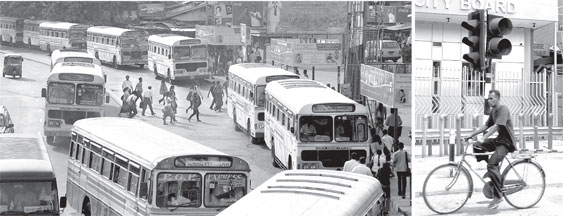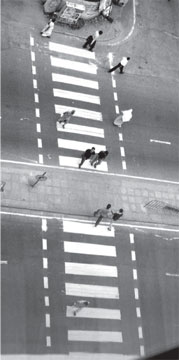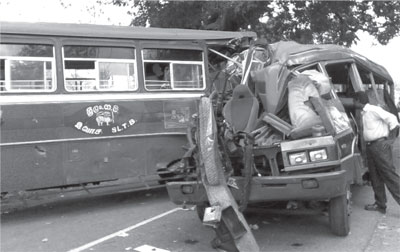Staying safe on the road

by Lionel WIJESIRI
 Each year, globally, nearly 1.3 million people die as a result of
traffic accidents on the road; more than half this number are not
travelling in a motor vehicle. Each year, globally, nearly 1.3 million people die as a result of
traffic accidents on the road; more than half this number are not
travelling in a motor vehicle.
If we focus on Sri Lanka, we find that over 100 road accidents occur
daily of which around 45 are fatal. Statistics reveal that last year,
over 2,600 persons died and property valued at Rs. 15 billion destroyed
due to these accidents.
Therefore, it is obvious that road traffic accidents lead to colossal
economic costs, at family and national levels. Some of these costs are
private (e.g., risk of injury to drivers), but others are external
(e.g., pedestrian deaths and damage to property); hence policies to
reduce the number of accidents are potentially justified on economic
efficiency grounds.
Select Committee Report
 Four years ago, in March 2007, Parliament resolved that a Select
Committee be appointed to investigate the adequacy of road networks to
meet the increasing number of vehicles, whether there is a total
disregard of road rules by the users inclusive of motorists, cyclists,
pedestrians and others and whether there is a failure on the part of the
police to enforce the rules of the road and punish offenders. Four years ago, in March 2007, Parliament resolved that a Select
Committee be appointed to investigate the adequacy of road networks to
meet the increasing number of vehicles, whether there is a total
disregard of road rules by the users inclusive of motorists, cyclists,
pedestrians and others and whether there is a failure on the part of the
police to enforce the rules of the road and punish offenders.
Based on the submissions and evidence placed before the Committee,
the following were identified as key factors influencing traffic
accidents in this country.
* Indisciplined driving including speeding, overtaking at
inappropriate places, turning without signals on and driving which
account for more than half the number of accidents
* Inexperienced driving where 48 percent of the accidents were caused
by those who did not possess a valid driving licence or who had less
than three years' driving experience
* Driver fatigue where long hours of driving and lack of rest have
contributed to accidents
 * Rapid increase of operational vehicles * Rapid increase of operational vehicles
* Heavy traffic volumes — 59 percent of road accidents occur in the
Western Province, especially within a radius of 50km from the Colombo
City Centre.
* Shifting from public transport to private vehicles due to various
reasons including the poor condition of public transportation and
greater flexibility.
* Deficiencies in the enforcement mechanism in relation to detecting,
prosecuting and punishing offenders.
* Shortcomings in issuing licences including examining suitability of
applicants when issuing and renewing licences as well as adding de-merit
points to the licences of offending drivers
* Delay in prosecuting traffic cases in Courts
* Poorly designed roads — lack of pedestrian footwalks, wide
shoulders, crossings, adequate lighting, road markings, signs and
traffic signals
* Frequent damage done to the roads due to laying of underground
electricity cables, telephone cables and water pipes.
* Erosion of roads due to rain water flow as a result of inadequacy
in the drainage system
* Carelessness of pedestrians contribute to high pedestrian
fatalities and casualties; 50 percent of these pedestrian fatalities
have occurred within urban areas
* Negligence of road rules especially non-compliance of crossing
roads on a yellow line or pelican crossing
* Using vehicles that are not roadworthy and have mechanical defects
such as ineffective brakes, no headlights, front lights and signals
The list is comprehensive and covers almost all causes of Sri Lanka's
road accidents.
Experts believe that the solutions lie in four broad policies: those
that reduce the vehicle miles travelled (VMT), improve driver and
pedestrian behaviour (e.g., driver or pedestrian education, speed
limits, penalties for drunk driving and jay walking), improve vehicle
safety (e.g., requirements for airbags and child seats), and improve
road infrastructure (e.g., crash barriers).
This article proposes to touch on two aspects of these policies:
driver education and behavioural approaches.
Driver education
 Driver education and training has been perceived as an important form
of policy intervention, reducing the number of road traffic accidents by
influencing drivers’ actions through changes in their ideas, feelings,
goals, and knowledge. Driver education and training has been perceived as an important form
of policy intervention, reducing the number of road traffic accidents by
influencing drivers’ actions through changes in their ideas, feelings,
goals, and knowledge.
The role of human factors in road accidents has received great
attention in the past. On-the-spot accident investigations in the US,
the UK, and other countries have shown that human factors are
responsible for the majority of accidents.
Age is an important human factor in many road traffic accidents. Each
age group in the driver population poses different road safety problems.
For example, the problems young drivers in our country face have been
mainly due related to misuse of the automobile, aggressive driving, and
sometimes driving with no licence.
Aggressive driving behaviour usually involves illegal and dangerous
driving, committed with the intent to gain an advantage over other
drivers. Examples of aggressive driving include exceeding the speed
limit, passing on the shoulder of the road, failure to yield, unsafe or
erratic lane changes, improper signalling, and failure to obey traffic
control devices. Aggressive driving is a common sight in our country.
Overall, our road safety education is poor. For example, drivers’
knowledge of traffic laws and emergency services is minimal. The
government in the past has encouraged the establishment of private
driving schools, but instructions in those schools is mainly theoretical
rather than practical. Many drivers think that these schools are useful
only as tools to obtain a driving licence. Thus, the courses may not
have been well designed for the purpose of actually improving safety on
the roads.
Behavioural approaches
While structural approaches to preventing road trauma, such as
changes to the road structures, will lead to many positive safety
advantages, driver behaviour will still remain a key impediment to
further progress. Unlike most diseases that have been prevented with
vaccines, most traffic injuries cannot be controlled quickly by
introducing a vaccine-like technology, as the technology must be proven
safe, adopted by people, and used properly to be effective.
Behaviour-based strategies have succeeded in reducing both
injury-risk behaviour and injury outcomes. The most successful
strategies have been planned and implemented with a theoretical
framework such as behaviour modification or applied behaviour analysis.
Perhaps the most widespread use of behavioural technologies to modify
road-use behaviour has been applied to behaviour analysis. This
framework uses contingency management through various forms of rewards
and incentives, behavioural shaping, and modifying environmental cues
and conditions to affect driver, occupant, and pedestrian behaviour. At
the societal level, laws and enforcement strategies that discourage or
punish risky behaviour are a form of contingency management.
For example, in studying drinking and driving, analysts are
interested in identifying the roots of the causes.
(a) Study before the behaviour happens. Why does one drink before
driving? Is it social atmosphere, peer pressure, stress of day’s work or
pure habit with no reason?
(b) Study the behaviour itself such as frequency and speed of
drinking, and the drinking and driving environment; and consequences
(c) Study the actions that follow the behaviour, such as social
attention, attitudinal changes, punishment in the form of DWI (driving
while intoxicated) arrests.
Understanding the ABCs of a behaviour chain can help the behaviourist
shape the individual and the environment to yield change. Reminders,
prompts, incentives, and cues in the environment can be used to modify
antecedents.
Social support, feedback, reinforcement, and punishment (or
perception of punishment) can be used to modify the consequences of the
behaviour. Application of these strategies, and others that rely on
legislative and enforcement strategies to change behaviour, have been
found to be effective. Behavioural road safety intervention research has
been used in many advanced countries to modify safety belt use, drinking
and driving, use of child restraints, speeding, and other risky road
safety practices.
Independent agency
The World Health Organization predicts that by 2020 road trauma will
be the world's third leading cause of death and disability, after heart
disease and mental depression. These facts make vehicle-injury
prevention one of the most formidable social challenges of the future.
Road traffic injuries and the number of deaths can be minimised.
Experience suggests that an adequately funded independent agency and a
national plan or strategy with measurable targets are crucial components
of a sustainable response to road safety.
|

